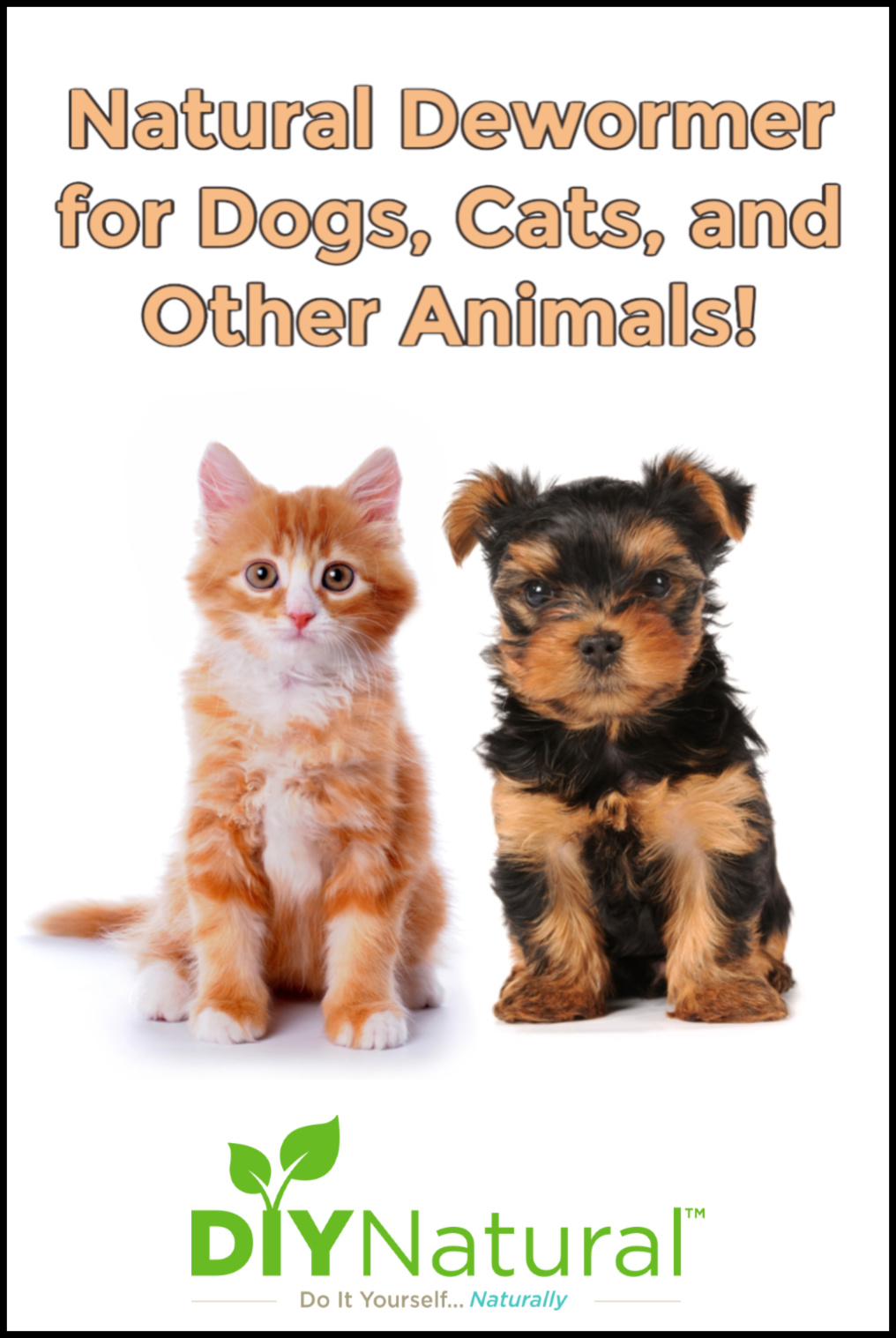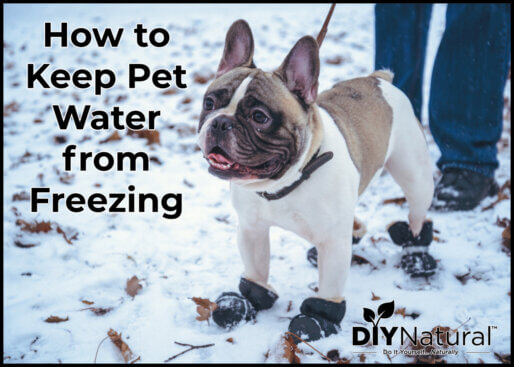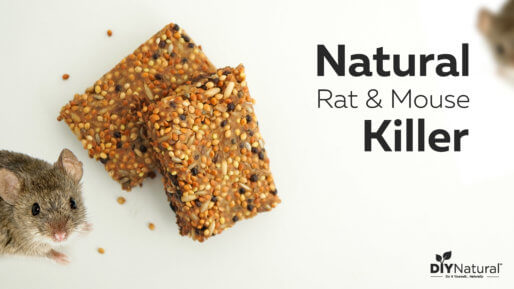
This homemade and natural dewormer for dogs and cats is simple to make and administer. It also works for chickens, goats, cows, and horses!
When you have animals, and most of us do, they’re bound to get parasites from time to time. Fleas and ticks are the first things that come to mind, but worms, pinworms, hookworms, and roundworms, even tapeworms can make your pets very sick. Whether it’s dogs, cats, chickens, or goats, you can use this simple dewormer with all of them, making slight variations here and there.
Natural Dewormer
While worms are a natural part of the environment, internally, they can cause a lot of problems with your pet’s health. They can become listless and lose weight, the coat can become dry and lackluster, and there may be vomiting or diarrhea. Loss of appetite comes with this, and in extreme cases, death can occur. This is something we all want to avoid. This recipe can be mixed with the pet’s food so it makes it very easy to administer.
Natural Dewormer for Dogs, Cats, and More
You’ll need a cup of each item, although you can make a lot and store it for later as it’s kept dry with no liquid. If you want to make bulk, you can use more of everything. Just keep the amounts even.
- Dried sage leaves, crumbled
- Dried oregano leaves, crumbled
- Ground pumpkin seeds
- Dried thyme leaves
- Dried red clover (red clover is really purple)
- Ground Fennel seeds
- Dried hyssop leaves and flowers
- Dried papaya seeds
- Rosemary and mint work in sheep and goats, but can be too strong for cats and dogs
- Food-grade Diatomaceous Earth or finely ground eggshells
Mix well and keep in a sealed container in a cool, dry place.
Using Your Natural Dewormer
For most animals the way the mix is used is similar.
Dogs
- Puppies and small dogs – ½ to 1 teaspoon
- Dogs under 50 pounds: 1-2 teaspoons
- Dogs over 50 pounds: 1 Tablespoon
- For dogs over 100 pounds: 1-2 Tablespoons
As a natural dewormer for dogs, add it to the daily feed. I do this for a few days, then wait a week and do it again. Worms have a 7-14 day incubation period, so dosing every seven days or so can usually catch them all.
Cats
- Kittens: ¼ – ½ teaspoon
- Cats: ½ – 1 teaspoon
As a natural dewormer for cats, add it to the daily feed. Again, cycle through 7-14 days to catch most of the worms as they hatch.
Goats
For goats, mix 1 Tablespoon with 1 teaspoon of dehydrated garlic and add to the daily feed, cycling as above.
Chickens
With chickens, mix in 5% into the daily feed, cycling as above.
Horses and Cows
For horses and cows, mix in 2% of daily dry feed, cycling as above.
As a natural dewormer for dogs, and all animals, remember to provide fresh, cool water. I add a bit of apple cider vinegar to the water as a further preventative and treatment.
Tip: search videos on the subject of diatomaceous earth for deworming different animals.
Cleanliness Matters
And keeping the area your pets are in makes a huge difference. Chicken coops are messy and smelly, making them hard to keep clean. I lined my walls and floor with linoleum to help keep it clean. Use a fly strip in the summer to help control flies. They can transmit parasites as well as rodents. Keep all of your feed under wraps to be sure there are no mice or rats feasting on the feed. All these matters will increase the effectiveness of this natural dewormer for dogs and cats.
Effectiveness of This Dewormer
The main ingredient is the food-grade Diatomaceous Earth. It is made of crushed diatoms, coral-like creatures that have the structure of tiny crystal shards when crushed. The shards are so small that they can’t hurt you or your pets, but they can damage invertebrates. They can irritate eyes and nasal passages but are just dusty on your skin. On a flea or tick though, it will form crisscross scores on the shell, either dehydrating the insect or drowning them, depending on if it’s used with water or not. There is no chemical for the pest to become immune to, so it can be used with success every time.
Deworming is a part of raising animals so why not try a natural dewormer for dogs, cats, and other animals?
*******




If you do not have hyssop locally, check Mountain Rose, they carry the leaves and flowers
Hi Kim and Julie, Do you speak from actual experience? If so, I’d like to hear about it. When this mixture is blended with any food, the DE mixes with the oils or molasses in the food and becomes damp and there is no way for an animal to inhale it. Hope this alleviates any worries. This was actually suggested by a vet rather than to used chemical wormers that pests can become immune to over time.
I’d advise not using DE for internal parasite control. There’s no solid evidence that it is effective internally, and obviously won’t work on parasite eggs. There is also the danger of an animal inhaling the powdered form and that can cause serious lung damage.
Hi, Debra,
Thank you for this recipe. It will be especially helpful when I first rescue dogs and cats for TNVR. Then, here is how I would treat the animal.
After you deworm and do a second time around to make sure all worms are destroyed, INSTEAD of continuing with this treatment you can add one drop Black Walnut Tincture (not extract) per 10 lbs body weight daily for dogs or 1 drop every OTHER day for 5 lb and up for cats. I have been doing this for years and my animals always get a perfectly clean bill of health. This kills all larva inside the body and this can be added to their food, as well. Also, to help boost the immune system and keep ringworm at bay, I use the OACV, daily in their food. I do not know if the Blk.Wal. Tincture would work with any other type of animals besides dogs and cats.
If someone has a cat or dog with ringworm, using OACV full strength 2-3 times daily for 1 week usually kills the infection and stops the spread to other parts of the face and body. (Just thought it would be nice to share this info.)
Sincerely
Aleta Ridgway
Please don’t use acronyms that aren’t used globally and well known: what is TNVR?
What is OACV?
I am so sorry. Please forgive me. TNVR is Trap, Neutered, Vacinated, Returned. OACV is Organic Apple Cider Vinegar. Again, my apologies. I did think those acronyms were world wide.
Oh, thank you. The TNVR may be well known in the animal rescue community, but not all of us. Makes sense.
The OACV, well, usually we just use ACV…I guess the O is understood…
Thank you for clarifying.
It just dawned on me that in animal rescue they used to use TNR but recently added the ‘V’ in with the other letters. Never thought about if someone isn’t associated with animal rescue. Also, for years I just bought ‘ACV’ and didn’t understand the difference the ‘O’ for organic meant. Because the organic will always have the ‘mother’ (fermentation pieces) in it whereas the regular ACV doesn’t. It’s the ‘mother’ that gives the healing properties to people as well as the animals. Can’t thank you enough for asking me what the letters stand for, so I have had the chance to explain and help others to know. Thank you so very much. 🙂
I always buy organic raw with the mother, that’s why I “assume” that is what is meant when someone says ACV. Guess I should start using OACV…
It is difficult, I know, when you are used to something and use it frequently to not be aware that not everyone knows what you do! It happens in all areas of working/volunteering.. People don’t really know what every job entails, even the so called known jobs. Mailmen: they deliver mail: there is SO MUCH more to it than that! Truckers: they drive trucks…again, much more to it than just that…etc..
No worries, now I know something new!
Me too. lol Never too old to learn. (72 here. lol)
can this be done maybe once a month for a few days or must we wait until the animal shows signs of discomfort.
as with Gable, following
If you don’t have access to hyssop, is there a substitute or can you just omit? Many thanks!
yes i too need to do this!
Have you received an answer? Please let me know. Thank you. 🙂
no
I am noticing that.